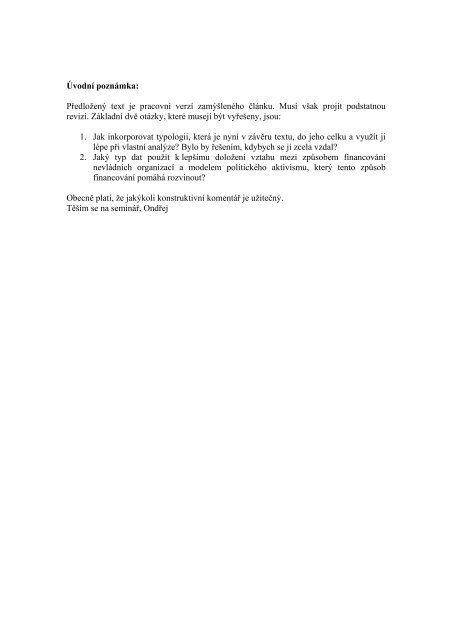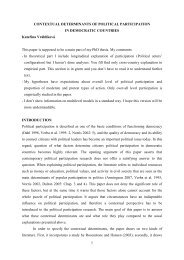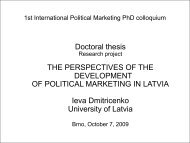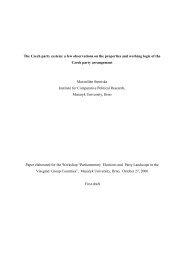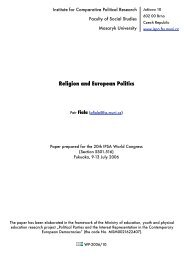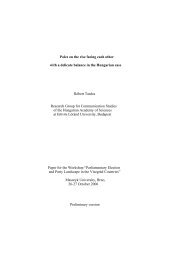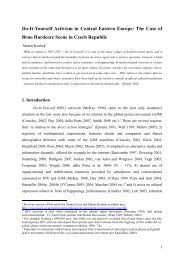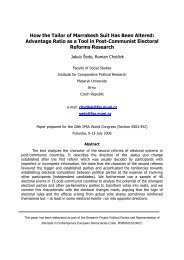Ãvodnà poznámka: PÅedložený text je pracovnà verzà zamýšleného ...
Ãvodnà poznámka: PÅedložený text je pracovnà verzà zamýšleného ...
Ãvodnà poznámka: PÅedložený text je pracovnà verzà zamýšleného ...
Create successful ePaper yourself
Turn your PDF publications into a flip-book with our unique Google optimized e-Paper software.
Úvodní poznámka:Předložený <strong>text</strong> <strong>je</strong> pracovní verzí zamýšleného článku. Musí však projít podstatnourevizí. Základní dvě otázky, které musejí být vyřešeny, jsou:1. Jak inkorporovat typologii, která <strong>je</strong> nyní v závěru <strong>text</strong>u, do <strong>je</strong>ho celku a využít jilépe při vlastní analýze? Bylo by řešením, kdybych se jí zcela vzdal?2. Jaký typ dat použít k lepšímu doložení vztahu mezi způsobem financovánínevládních organizací a modelem politického aktivismu, který tento způsobfinancování pomáhá rozvinout?Obecně platí, že jakýkoli konstruktivní komentář <strong>je</strong> užitečný.Těším se na seminář, Ondřej
Transactional Activism as a Result of Democracy Assistance to East-CentralEurope: The Case of the Czech RepublicOndřej CísařIntroductionThe political mobilizations that marked the end of communist regimes in many EastEuropean countries raised high expectations, especially among Western observers,regarding the future of democratic citizenship in the region. When reading reflections onEast European ‘revolutions’, one cannot but conclude that there was a wide belief in thepossibility of reinvigorated active political participation in post-communist countries.However, after a short period of enthusiasm it became clear that these hopes would notmaterialize in the foreseeable future. East Europeans simply refused to fulfill the radicaldemocratic hopes of some academic enthusiasts. The tone in the literature changedaccordingly. There was a perceptible shift from the early emphatic enthusiasm about EastEuropean citizens, to a gloomy picture of passive, disinterested and cynical EastEuropean sub<strong>je</strong>cts. Many reasons for this perceived failure on the part of East Europeanswere enumerated. Communist legacies, post-communist disappointment, and theinappropriate strategies of West European democracy promoters stand out among them.This paper takes issue especially with the latter argument. It claims thatinternational influence, which did indeed leave a deep imprint on East European civilsocieties, did not curb opportunities for political activism in the region, but helped createa particular activist form that is overlooked, if one looks only on the participatory side ofactivism. Although it was persuasively demonstrated that on average East Europeansparticipate less than their counterparts in the established democracies, it does notnecessarily follow that civil societies in post-communist countries are weak. The papersupports its claims with the help of evidence taken from several sectors of politicalactivism in the Czech Republic.The first section of the paper outlines the debate on political activism in East-Central Europe (ECE). Drawing on the paper recently published by T. Petrova and S.Tarrow in this journal, it differentiates between two forms of political activism:participatory and transactional. The second section asks what accounts for thedevelopment of transactional activism in ECE. In order to find the answer, the sectionfocuses on the resources available to social movement organizations (SMOs) in ECE ingeneral, and in the Czech Republic in particular. It shows that advocacy SMOs relied interms of their funding on predominantly foreign sources. The third section presents thecurrently prevailing assessment of foreign civil-society-building programs, in order tochallenge some of its presuppositions in the fourth section. Hence, the fourth sectiondebates the consequences of foreign funding for political activists and political contentionin the Czech Republic, and strives to confront the currently dominant view thatunderscores its negative sides. The paper concludes by putting the study of politicalactivism into the con<strong>text</strong> of a broader debate on the quality of democracy.Political Activism in Eastern EuropeThere are two bodies of literature on the state of organized political activism in ECE (fora review see Petrova & Tarrow, 2007). The first body includes studies focused onindividual participation. These studies consistently show low levels of organizational1
membership in the ECE countries. For example, on the basis of the 1995-97 WorldValues Study, Marc Howard (2003) documents that the average number of membershipsin voluntary organizations per person in the group of post-communist countries issignificantly lower than in the older democracies and post-authoritarian countries. 1 Whilethe older democracies mean is 2.39, and post-authoritarian regimes score 1.89, the postcommunistcountries mean lags significantly behind with just 0.91. In addition, whenHoward makes the comparison among the three groups of countries according to differentorganizational types, the results point in the same direction. The only exception is laborunions. Particularly low levels of membership are displayed by politically-orientedorganizations, such as political parties and environmental groups, and church,educational, cultural, and artistic organizations.Studies that focus on individual participation have regarded the low level oforganizational membership in Eastern Europe as an indicator of weak civil societies inthe region. However, the second body of literature on political activism in ECEchallenges this account by showing the well-developed structure of advocacyorganizations in that same group of countries. Although these studies do not dispute thefacts documented by the individual-level scholars, they doubt that they provide a fullpicture of political activism in ECE. These studies document an impressive growth in thenumbers of various non-governmental organizations (NGOs) across the region. Thisshows that although there was not much mobilization on the individual level, there wasindeed a great deal of organizational development in the sphere of political activism after1989. The data used by the individual-level scholars demonstrate the limited ability ofthese organizations to mobilize; however, they do not say anything about other aspects ofactivism.The available evidence seem to suggest that some of these organizations havegrown into relatively effective advocacy groups that have the capacity to influence thedecision-making process on the national, subnational, and in some cases eventransnational levels (Toepler & Salamon, 2003; Císař, 2004; Petrova & Tarrow, 2007).Drawing on USAID studies, Petrova and Tarrow (2007) provide the most comprehensiveassessment thus far of the advocacy capacity of East European NGOs. The USAIDSustainability Index measures seven dimensions of the NGO sector: legal environment,organizational capacity, financial viability, advocacy, service provision, NGOinfrastructure and public image. In general, the advocacy dimension that interests us herecaptures “NGOs’ record in influencing public policy.” It analyses “the prevalence ofadvocacy in different sectors, at different levels of government, as well as with theprivate sector”, and considers “the extent to which coalitions of NGOs have been formedaround issues …, as well as whether NGOs monitor party platforms and governmentperformance.” (USAID, 2005)The USAID data seems to substantiate the claim that East European NGOs havedeveloped a considerable advocacy capacity. According to Petrova and Tarrow, althoughthese organizations lack the ability to mobilize individuals, i.e. to engage them in“participatory activism”, they nevertheless fare much better in terms of “transactionalactivism”. Transactional activism means “the ties – enduring and temporary – amongorganized nonstate actors and between them and political parties, power holders, andother institutions.” (Petrova & Tarrow, 2007, p. 79) In other words, the fact that EastEuropean organizations display low levels of organizational membership does not2
necessarily indicate the lack of any activism at all. On the contrary, by not limiting thenotion of activism to its participatory dimension one can “see a richer picture oftransactions consisting of coalition formation around single issues, network formation,and negotiation with elites on the part of civic groups in Central and Eastern Europe…”(p. 80)Sources of Political ActivismThe available explanations of political activism in ECE mostly focus on the reasons forindividual nonparticipation. Thus, according to Howard (2002; 2003), the legacy ofmistrust in organized participation under the communist regimes, the persistence offriendship networks, and disappointment with post-communist developments lie behindthe unwillingness of East European citizens to take part in voluntary organizations.However, as demonstrated in the previous section, this does not tell the whole story.Although the lack of participatory activism may be well explained by these factors,transactional activism still remains to be accounted for. Hence, the main question of thispaper is: What explains the peculiar pattern of political activism in ECE? In other words,what made it possible for transactional activism to develop in ECE?In order to identify the explanatory variable, I look at the resources available toadvocacy organizations to sustain themselves. As the adherents of the resourcemobilization paradigm pointed out long ago, political activism is based on the availabilityof resources, such as money, time, leadership skills, and expert knowledge (McCarthy &Zald, 1977; Jenkins, 1983). As the presented evidence shows, East European advocacyorganizations have been unable to rely on resources provided by their membership base.There have been few members to provide organizations with their time and financialcontributions. Thus, the necessary resources have had to come through different channels.In general, the dominant source of funding for NGOs in ECE in the 1990s wasearned income, fees, and charges. These sources of funding comprised 46 percent ofNGO revenues in 1995/96 (Toepler & Salamon, 2003, p. 372). However, as Toepler andSalamon point out, this number reflects the prevalence of fee-dependent cultural andrecreation organizations, professional associations and trade unions in the nongovernmentalsector in ECE (for the composition of the sector, see Table 1). As a result,the aggregate number does not tell us much about the situation of advocacyorganizations.[Table 1 about here]Statistics show that different types of organizations vary greatly in terms of theirrevenues. I will support this claim below with the data on the public funding of differenttypes of organizations in the Czech Republic. There is, however, no systematic evidenceavailable on the volume of earned income, fees, and charges according to theorganizational type. Taking into account what was said in the previous section, thiscategory should not play any significant role in the budgets of advocacy organizations.Although I am unable to support this hypothesis by systematic evidence, I cannevertheless provide some data taken from the Czech Republic’s environmental sector.The table below shows the weight of earned income and of all types of contributions byindividuals (not necessarily membership dues) in the budgets of five advocacyorganizations that played a visible role in the environmental campaigns of the 1990s, and3
that are regarded in the literature as the most important advocacy organizations in theCzech green movement (Fagan, 2004; Davis, 2004).[Table 2 about here]As Greenpeace Czech Republic presents an important exception among advocacyorganizations in the Czech Republic, I will not consider it for the time being, and willcome back to it later in the paper. Unlike other organizations, it actually managed tomobilize a sufficient number of individual contributors by 2002. Here, I will focus on theremaining four SMOs. Although there are important differences among them, the tabledemonstrates that even the most successful of them – the Rainbow Movement – was stillin 1998 able to generate only 16.6 percent of its revenues by its own means. 2 Although itis not possible to get hold of the organizations’ annual reports from the early 1990s(generally, there were no reports published at that time), I can reasonably suppose that thesituation prior to 1998 in terms of the organizations’ ability to sustain themselvesindependently of external sources was even worse than in the period captured in the table.Indeed, this inference is supported by all the available studies (Fagin & Jehlička, 1998;Fagin, 2000; Fagan & Jehlička, 2003; Fagan, 2004; 2005; Davis, 2004; Jehlička, Sarre &Podoba, 2005). Given the lack of exact data, additional indirect evidence on the limitedcapacity of advocacy organizations to mobilize resources from indigenous sources isprovided by public opinion polls that demonstrate on the one hand the relatively highreadiness of the Czech population to donate money to voluntary organizations, while onthe other hand showing that most of that money is devoted to charity and service-orientedorganizations (STEM & NROS 2004).The level of public sector funding for NGOs is over the ECE average in the CzechRepublic. While the average for ECE countries was 33 percent in 1995/96, in the CzechRepublic public sector funding formed 39 percent of organizations’ budgets at that time(Toepler & Salamon, 2003). Again, as illustrated by Tables 3 and 4 below, theirdistribution among different organizational types was very uneven. The bulk of publicfunding was channeled to the areas of social services and sport activities. Advocacyorganizations received almost no public funding. In 1999 environmental organizationsobtained just 3 percent of all public funding, organizations fighting for the rights ofethnic minorities 1 percent, and consumer rights organizations received no subsidies atall. Also in 2003 advocacy organizations, represented in Table 4 by environmentalistsand gender equality groups, received almost no subsidies from public sector sources.[Table 3 about here][Table 4 about here]These findings are widely supported by research on the non-state sector in theCzech Republic. On the basis of the data from the Johns Hopkins Comparative NonprofitSector Pro<strong>je</strong>ct, P. Frič shows that although the public sector funding of the nongovernmentalsector in the Czech Republic was on the rise in the 1990s, advocacyorganizations newly established after 1989 received almost no benefit from it. Publicsector funding displayed a highly path-dependent pattern, as service-orientedorganizations that already existed before the collapse of the regime were the ones tobenefit the most from it. According to Frič (1999, p. 98), this method of funding worked4
as “a selection mechanism that privileged one type of organizations, and was to adifferent extent harmful to others. Most harmed were organizations advocating humanrights”. The main reason for this lack of support in the 1990s was the hostility of thattime’s political elite towards social movements and advocacy associations. As Table 4demonstrates, this attitude established a pattern that survived well after its main initiatorslost their positions.As the available evidence shows, advocacy organizations in the Czech Republicwere able to rely neither on earned income, nor on public sector subsidies. The bulk oftheir activities have been financed through various foundations, mostly foreign, and grantprograms. In order to illustrate this point, Table 5 gives an overview of grant funding forthe five Czech environmental organizations I mentioned earlier. With the notableexception of Greenpeace Czech Republic, the table shows that the majority of theirbudgets were financed by various foundations’ grants (grants provided by stateinstitutions are excluded from the table).[Table 5 about here]From the beginning of the 1990s, the organizations of the Czech environmentalmovement depended for their funding mostly on external donors. Funding sourcesincluded, among several others, the Swedish environmental organization Acid Rain,agencies such as United States Agency for International Development (USAID), theDutch Embassy, the German Marshall Fund, the British Know How Fund, and at a laterstage funding coming from the EU through the Regional Environmental Center and thePhare Program (Fagan, 2004). In the 1990s these sources constituted the most importantsource of income for Czech environmental advocacy organizations. Moreover, althoughsome of the more established groups have recently employed active strategies to mobilizeindividual supporters, with the exception of Greenpeace Czech Republic grant fundingprovided by various foundations continues to be their single most important source ofmoney.‘Civil Society’ BuildingInternational aid programs aimed at democracy promotion and building civil society inparticular have flourished since the beginning of the 1990s both in the US and WesternEurope. 3 As ‘vibrant civil society’ began to be widely regarded as an importantprecondition for political stability and democratic accountability, various programs aimedat promoting ‘civic virtues’ were designed and executed by development agencies, publicand private foundations, and several other institutions in ECE (Wedel, 1998; Carothers,1999; Mendelson & Glenn, 2002; Henderson, 2003; Scott & Steele, 2005). In thebeginning of the 1990s, US programs and programs by individual European governmentsplus US private foundations provided most of the funding. Later on, as the ECE countriesembarked on the way to the EU, many of these agencies declared them to be relativelystable regimes, scaled down their programs, and moved eastwards. At that point, grantsprovided by the EU became the most important source of funding for advocacyorganizations throughout the region.At the beginning of the 1990s, the concept of civil society became fashionableamong democracy-promoting agencies around the world. In an idealized neo-Tocquevillian understanding of civil society promoters, civil society started to be5
understood as an associational arena formed by voluntary associations, independent fromboth state and economy. Civic associations were expected to provide citizens with ameans of political participation and to put a check on decision-making processes takingplace within the formal structure of state institutions. It was believed that by supportingthese relatively independent agencies, political reforms in transition countries would beserved better than if money were provided directly to agents within the state bureaucraticstructure, who lacked the flexibility and even the willingness to embark on the path ofreform (Carothers, 1999).Civil society is, however, quite a fluid concept. In order to make it operative, ithad to be expressed in terms that would be understandable to potential funders. As theavailable research on democracy promotion suggests, since the beginning of the 1990ssupport for civil society has been conflated with the support for advocacy NGOs(Henderson 2002; 2003; Aksartova, 2006). Thus, when analyzing the USAID programsaimed at civil society building in Eastern Europe, Thomas Carothers (1999) shows thatthey focused predominantly on NGOsdedicated to advocacy for what aid providers consider[ed] to be sociopolitical issuestouching public interest – including election monitoring, civic education, parliamentarytransparency, human rights, anticorruption, the environment, women’s rights, andindigenous people’s rights… Aid officials have in fact begun to call the advocacyNGOs they supported under civil society programs “civil society organizations,”misleadingly implying that these few, usually rather new and specialized organizationsrepresent the core or even the bulk of civil society in the countries in question. (p. 210)By providing funding only to this particular organizational type, promotersactually enforced it across the region of ECE, causing a tremendous increase in numbersof NGOs in all transition societies (Carothers, 1999; McMahon, 2001; Henderson, 2002;2003; Narozhna, 2004). As there were almost no other potential sources of fundingavailable, the imperative of organizational survival dictated adapting to fit the agenda anddemands of foreign donors. By now, this seems to be a well-established story ofdemocracy promotion in post-communist societies.According to critical assessments of civil society programs, in the beginning ofthe 1990s there was a widely held belief among Western political and intellectual elitethat the fall of communism had equaled a total institutional collapse (Stark & Bruszt,1998). According to this view, the collapse of communist regimes brought an‘institutional vacuum’ that called for programs that would create new institutions fromscratch. In the area of civil society building this attitude allowed for disregarding thealready existing organizations, and according to critics, ultimately resulted in thecomplete disregard of the indigenously developed interests and collective identities(Phillips, 1999).According to this criticism story, by providing institutional support Westerndonors not only directly influenced agendas pursued by East European ‘independent’organizations, but also redirected their activities from domestic mobilization of theirconstituencies to transnational grant-seeking (Narozhna, 2004). Instead of empoweringand making these organizations able to become means of participation, the programscreated dependency among them, and made them caught in an endless vicious circle ofgrant applications. Thus, the foreign-funding dependent East European NGOs have6
ecome ‘ghettoized’ in the sense that “they are closer to their transnational partners thenthe constituents they are meant to represent or the governments they claim to beinfluencing” (Henderson, 2003, p. 13; see also Mendelson & Glenn, 2002). According tothe harshest critics, these programs actually prevented East Europeans from creating theirindigenous social movements; instead, they imposed on them a particular organizationalpattern that was inimical to the idea of popular movements. As a result, like thecentralized state before the collapse of communism, incompetent Western donors after itsend suppressed popular participation in ECE (McMahon, 2001).Due to the Western funding, East European civil societies were populated byrelatively formalized and professionalized advocacy organizations. In order to becomeeligible for funding, organizations had to adapt to the organizational model that wasrecognized by donors as the legitimate manifestation of civic associations – an advocacyNGO. According to the critics, the variability of potential civil society organizations wasthus reduced to the narrow conception of professionalized advocacy organizations unableto engage citizens in genuine contestation and political contention. Instead of socialmovements, public interest groups mushroomed in the region. In terms of their actionrepertoire, these organizations preferred cooperation with political authorities to morecontentious forms of claims making. Hence, popular mobilizations across the region thataccompanied the regime collapse gave soon way to a more institutionalized andmoderated form of ‘interest politics’. From this point of view, the perceived promise ofEast European ‘revolutions’ to reinvigorate citizen participation has never materialized inpractice. After the regime collapsed, people turned their backs on politics, which startedto be occupied by professional political elites in both the state and civil society. The trendthat had been set in motion already in the beginning of the 1990s was even reinforcedafter most of the original donors scaled down their programs in the second half of the1990s. At this point, the EU became the dominant source of foreign funding. The EUprograms strengthened the pressure towards institutionalization and professionalizationeven more. The question I want to address in the remainder of the paper is: were reallythe consequences of external funding as crippling as the above reviewed arguments seemto suggest?Consequences of External FundingThe available research on the impact of foundation funding seems to suggest that byproviding funds, philanthropic institutions actually contribute to the co-optation of socialmovements by political elites. This results in a professionalization of the activities ofsocial movements that “siphons movement activists from grassroots organizing, therebydiverting them from their original goals and demobilizing the movements” (Jenkins,1998, p. 212). Hence, according to this thesis, foundations, on some accountsconsciously, help transform militant movements into more moderate and less contentiousactors. Instead of the co-optation thesis, C. Jenkins comes up with an alternativechanneling thesis. He argues, first, that “foundation goals are complex”, thus, it is notpossible to see foundations only as tools of social control; second, that “the main impactof movement philanthropy has been professionalization”; and third, that“professionalization has frequently created greater mobilization and social movementsuccess.” (p. 212)7
In his research on US social movements Jenkins shows that it was indeed thecase: foundation funding did not necessarily lead to co-optation and goal displacement onthe part of social movements; rather, it contributed to the professionalization of somecomponents of the movements, and “allowed them to consolidate their gains and protectthemselves against attack.” (p. 215) According to Jenkins, the US social movements’activities were not co-opted, but channeled towards professionalization that did notnecessarily diminish the importance of indigenous components of the movements. Exceptfor the consumer protection movement, in all other sectors studied by Jenkins indigenousgroups made up most of their action between 1953 and 1980. Therefore, despite thegrowing professionalization of the movements, Jenkins concludes that there was nodisplacement of indigenous activity by professional organizations in the US.The situation was different in ECE. While in the US foundations reacted to themobilizations of the 1960s, and channeled already existing social movements; there wereno consolidated social movements in ECE after the fall of communism. Although a waveof episodic mobilization and contention marked the end of the communist regimes acrossthe region (Rudbeck & Sigudsson, 1999; Glenn, 2003), this mobilization did not directlygive birth to a group of social movements that would represent a set of recognizableclaims. In Czechoslovakia, the movement that emerged out of the anti-communistmobilization soon dissolved into a number of political parties and other groups. Inaddition, some of the organizations that allegedly represented interests of varioussegments of society had already existed under the communist regime; however, theseorganizations were controlled by the regime and served as tools of social control over thesociety. All this meant that in Czechoslovakia various social movement sectors began toform exactly at the time when foreign funding arrived to build a ‘vibrant’ civil society.As I showed in the previous sections, the emerging advocacy organizations haverelied almost fully on foreign funding from the very beginning of the 1990s. Research onvarious sectors of social movement organizations (SMOs) in the Czech Republiccontends that these organizations became almost fully dependent on foreign funding, andas a result did not have any motivation to mobilize individual supporters within thecountry. There were no indigenous social movement organizations within the country;thus, there was no channeling of their mobilization similar to that observed by Jenkins inthe US. It seems as though from the very beginning the emerging social movementorganizations have been co-opted by the political system, moderated in their demands,and relatively institutionalized in terms of their organizational structure. Instead ofpotentially disruptive social movements, structural conditions after the fall of the oldregime gave birth to professional NGO activists, who were trained more in grantapplications and lobbying than in mobilizing. In the remainder of the paper I will firstillustrate these claims by looking more closely at the results of the available research onorganizations in the environmental and women rights’ sectors. Second, I will question theone-sidedly negative account of the consequences of foreign funding by challenging theassumption found in these accounts that an alternative – indigenously based – fundingwould bring actors capable of taking a more contentious stance towards politicalauthorities.To start with, I will turn to Czech environmental organizations. The first postcommunistgovernment established a “State Fund for the Environment” that was tocollect the money from polluters’ fines and licenses. However, this money was not made8
available to advocacy-oriented SMOs, but was channeled towards “apoliticalconservation pro<strong>je</strong>cts pursued by the older EMOs” (Fagan, 2004, p. 91). The newlyestablishedorganizations had to apply for support from various funding agencies, and asFagan shows, in some cases even from multinationals. The result was, according toFagan, a de-radicalization of the movement. Instead of presenting an alternative to themainstream liberal market-based view of environmental protection, it embraced theliberal view and strove to become a recognized voice in the public debate. Theseorganizations “were keen to demonstrate their professionalism as well as their proximityto the policy process and the media.” (p. 99) And there was a price to be paid for theirincreasing influence. They had to abandon protest in favor of policy making and lobbyingthat in turn demanded increasing professionalization on their part. In addition, they lostthe ability to independently decide on their agenda. In order to become eligible forfunding, organizations’ goals had to fit the donors’ preferences (Fagan, 2004; 2005;Hicks, 2004).As the previous sections showed, in the beginning of the 1990s, mostly US-basedfoundations and sources from individual West European states supported this sector ofsocial movements. By the late 1990s, when the country was already firmly on its way tothe EU, these donors started to withdraw. The pre-accession EU funding, the money fromthe UNDP, and the continuing Soros Foundation programs filled the vacuum. As EUfunding gained in importance in the second half of the 1990s, the pressure towardsfurther institutionalization and “institutional procedures – lobbying, consulting on draftlegislation, researching and writing reports and opinions, attending public meetings”increased even more (Hicks, 2004, p. 225). According to critical voices, the actual effectwas to cripple the development of an autonomous environmental movement, because EUfunding only reinforced the already established relations of donor dependency. AlthoughEU funding strategy generally differs considerably from the earlier funding byemphasizing the long-term sustainability of NGOs, it nevertheless perpetuates the oldpattern by continuing to distribute pro<strong>je</strong>ct-based funding. Thus, Fagan (2005) concludes:On one hand the EU was, and still is, pushing local fund-raising and independence fromdonors, whilst on the other it offers direct funding for pro<strong>je</strong>cts, mostly concerningconservation and eco-education that require NGOs to produce reports, liaise withbusiness and government, and increasingly become involved with implementation andmonitoring of environmental-policy initiatives – in other words, the type of fundingcon<strong>text</strong> that NGOs were used to and arguably needed to move beyond. (p. 539)The research on women rights’ organizations also demonstrates that the shift inthe international con<strong>text</strong> of funding, from the US and European foundations andgovernments to the EU funding, resulted in an increased dependency, furtherprofessionalization, and a decrease in the organizations’ autonomy to set their agenda(Hašková & Kolářová, 2003). Similarly to the environmental SMOs, Czech women’sgroups have been dependent on external funding from the very beginning. However,while in the early 1990s these organizations were able to receive operational funding, theEU money is distributed on the basis of short-term pro<strong>je</strong>ct grants (Hašková & Křížková,2006). In order to get this type of funding, organizations need to fulfill a number offormal criteria, which forces them to professionalize and ‘pro<strong>je</strong>ctify’ their activities. Onlyformally registered organizations with offices and employees can qualify for EU funding.9
At the same time, a relatively well-developed organizational capacity helps them adjustto the specific conditions attached to the distributed grants. The organizations are in needof continuous funding, but most of the funding available is pro<strong>je</strong>ct-based; therefore, theyare forced to conceal costs not related to the pro<strong>je</strong>ct they apply for within the pro<strong>je</strong>ct’sbudget.In general, in order to ensure their survival, women’s organizations have had toadjust to the EU’s mainstream reform agenda in the area of gender. Organizations thatwere unable to reformulate their agenda ceased to exist. A case in point is a Prague-basedorganization that due to the changed funding pattern had to transform its agenda to fit theEU sponsored programs, appoint as its director a professional fundraiser, employ morestaff, and focus on grant applications and networking with public officials (Hašková &Křížková, 2006). Although except for very small groups (Kolářová, 2004) there were noradical feminist organizations even in the first half of the 1990s, the protracteddependency of the existing groups on the EU created a further obstacle for them toengage in some form of contentious action. As they seek cooperation with politicalauthorities, there is no way for them to voice a radical agenda. It would de-legitimizetheir standing in the eyes of decision-makers. In the case of women’s rights, this has beeneven further reinforced by the ideological climate in the Czech Republic that has beenvery unfavorable to the import of radical feminist demands even among the womenorganizations (Vráblíková, 2007).The evidence presented thus far has pointed to dependency on foreign funding asan important reason for the advocacy organizations to professionalize their activities andmoderate their strategies. According to some scholars, in order to facilitate the emergenceof more autonomous and contentious social movement actors in the Czech Republic, theSMOs would have to change the revenue structure of their budgets in favor of individualcontributions generated from within the country. It is argued that such a change wouldallow for a more independent agenda on the part of the local SMOs than is presently thecase. This agenda would mirror the needs of local population instead of donors’requirements. In addition, as they would be freed from the reporting obligations towardsdonors, they would also be free to engage in more contentious collective action. Thus A.Fagan (2005) hopes for a civil society that would shift “from elite-level ‘problemsolving’organizations that operate on the periphery of the elite, towards grass-rootsmovements and organizations that view civil society as a vehicle for articulatingalternative perspectives and opinions and for contesting power…” (p. 533). In order toapproximate this ideal, “Czech environmental NGOs need to follow the West Europeanexample and acquire a larger membership base that would provide them with sustainableincome” (p. 530).As there is one important organization in the Czech Republic – Greenpeace – thatfollowed Fagan’s recommendation and became self-sustainable by 2002, we cantentatively test Fagan’s claim and see whether the alternative funding strategy actuallyled to an alternative organizational development and a different set of political strategies.Greenpeace Czech Republic encountered severe financial problems in the second half ofthe 1990s that resulted in a decision by Greenpeace International to help devise a planthat would make the Czech organization fully self-sustainable. Greenpeace CzechRepublic embarked on this reform plan in 1998 and planned to achieve financialsustainability by 2001. In order to meet the plan’s ob<strong>je</strong>ctives, the organization hired more10
professional fundrisers, and a former business manager was appointed as director. Hencethe ambitious goals of the plan actually contributed to the increasing professionalizationof the organization, and introduced more formalized management techniques.There were consequences for the organization’s agenda as well. As Greenpeacesought to find resonance with broader public opinion, it refrained from somecontroversial campaigns that were taking place at that time in the Czech Republic, suchas the campaign against the completion of construction work on the second Czechnuclear power plant Temelín. Although Greenpeace International pressed the Czechgroup to engage on the issue as it did in the early 1990s, it was not deemed wise by thelocal organization at the time of the reform plan because it could discourage potentialcontributors. Although there was a robust campaign against the power plant in the late1990s (dominated by the foreign funding-driven Rainbow Movement – the Czechmember of Friends of the Earth), public opinion was constantly supportive of completingthe plant (Public Opinion Research Centre 2001). Thus, it was decided by Greenpeace tocreate the kind of ‘campaign mix’ that would be more attractive to potential supporters,and avoid too-controversial issues, at least until the program’s goals were achieved(interview 2):Having been in the middle of the reform plan aimed at self-sufficiency… so, severalpeople in the office just feared going into very controversial issues. And Temelínbefore completion in 2000 was still very controversial issue… Naturally, for forests,whales and for these explicitly green issues, one can get support easier than forsmoking power plants. It is generally known and it is related to something, which iscalled the appropriate campaign mix…As a result, the Czech organization focused on whales, and its campaign helpedthe country to get into the International Whaling Commission to tip the balance in favorof the so-called anti-whaling states. In other words, Greenpeace focused on improving its‘campaign mix’, which actually meant moderation and avoiding political controversy,which could arouse a negative public response. As a result of professionalization and anon-controversial stance, Greenpeace won its battle over finance and managed to recruita sufficient number of individual contributors by 2002 (see Table 2).The results in terms of organizational development and the strategy choices madeby Greenpeace heavily resembled the organizations that remained dependent on foreignfunding. In the case of Greenpeace too, one could observe a tendency towardsprofessionalization and moderation. Though via different route than the foreign-fundingdependentorganizations, Greenpeace ended up in a situation like that of a professionallydrivenpublic interest group. Moreover, like foreign-funding-dependent organizations thatare forced to devote substantial resources to grant management; i.e. to administration,Greenpeace devotes substantial resources to maintaining itself as a self-sufficientorganization. It spends important part of its budget on fundrising (see Table 6), and fourof its 14 employees work as full-time fundraisers (interview 2).[Table 6 about here]Independence from grants did not allow Greenpeace to become an agentchallenging the system. In fact, in order to make itself ‘sellable’ on the domestic market,the organization had to adjust to the demands of domestic public opinion. One cannot but11
ask whether it was not the foreign-money dependency that actually enabled someorganizations to swim against the current of public opinion and voice an agenda thatwould otherwise never find its way to the public debate, such as that over the Temelínnuclear power plant. A very similar situation occurred with the issue of ‘domesticviolence’ that was set for domestic women’s groups by their foreign partners, and wouldprobably have never made it to the political arena without them, given the way the issuewas denigrated and even ridiculed in the country in the beginning of the 1990s.ConclusionsIn this paper I first diagnosed the state of political activism in ECE, then drawing on therecent paper by Tarrow and Petrova I differentiated between participatory andtransactional forms. Subsequently, I asked what the reasons were for the emergence oftransactional activism in ECE. Using evidence from the Czech Republic, I endeavored toshow that the conditions for ‘transactional activism’ were created by foreign programs ofcivil society promotion that enabled, to put it in the words of T. Skocpol (1999),‘advocates without members’ to populate East European civil societies. These programshelped spread the organizational model of advocacy NGO throughout the region.Contrary to gloomy analyses presented by the critical scholarship on democracypromotion, I claimed that although these programs indeed failed to build membershipbasedorganizations, they nevertheless succeeded in creating the conditions for relativelyeffective policy advocacy to emerge in the region. By doing that, they undoubtedlyhelped local democracies to develop the infrastructure of interest mediation, although thishappened without a corresponding development in terms of increased citizenparticipation.The one-sidedly negative diagnosis of East European civil societies found in thecritical literature betrays more the ideological preconceptions of their authors than theactual development on the ground. By criticizing the ability of East European civilsociety organizations to mobilize a wide following, these authors pro<strong>je</strong>ct a participatorynotion of democracy into their analyses, and measure the reality of East European politicsby a highly idealized yardstick. Thus I claim that it is these critics rather than thedemocracy promoters, who have assumed in this literature the role of the ‘usualsuspects’, who have applied an idealized neo-Tocquevillian notion of civil society for theanalysis of East European civic life. As they do not see their radical visions ofparticipating citizenry thrive in the region, they conclude that there is actually no civiclife worthy of the name at all. In this paper, I intended to show that lack of participationdoes not necessarily mean lack of interest mediation. Moreover, some foreign-fundingdrivenorganizations have proven to be more effective political actors than the supposedlyautonomous indigenously-supported ones. Although I agree with the critics that thisdevelopment brought with it professionalization and moderation on the side of SMOs, Idoubt the validity of their assumption that the shift from international to indigenousfunding would bring a perceptible change in the organizational development and actionrepertoire of the SMOs.What type of democracy did foreign funders help create in the region? It is safe tosay that the participatory vision has never materialized. One should, however, askwhether it was reasonable in the first place to expect such development. Probably oneshould opt for a more realistic approach to political activism in ECE, and see that by12
creating conditions for civil society actors to organize and obtain resources, thedemocracy promoters managed to substantially contribute to the increased accountabilityof state institutions in ECE, although they did not (and probably could not) induce themasses to actively participate in politics. Therefore, I claim that these programscontributed to the building of liberal democracy as opposed to participatory democracy(see Table 7).[Table 7 about here]Table 7 presents a typology of democracy based on two dimensions. Four models(one of them non-democracy) are differentiated on the basis of the importance they attachto direct participation and the rule of law respectively. In the liberal understanding (thelower-left quadrant), democracy is tantamount to the kind of institutional and proceduralsetting that ensures a fair competition among various conflicting interests in the society(Shapiro, 2003). Political participation is given only instrumental meaning in this model –it provides a means for problem-solving. It is expected to help solve social and economicconflicts that cannot be resolved by individual actors without collective cooperation.Civil society organizations in this model are expected to ensure basic transparency of thepolitical process and to make the political elite accountable for its decisions. In otherwords, it is expected to ensure the accountability of formal political institutions. In orderto achieve that goal, civil society does not need to ensure active participation; thetransactional capacity of civil society actors is sufficient in this model.In the participatory understanding (the upper-right quadrant), it is not impartialrules that set the limits for political competition, but the formation of a ‘general will’within the framework of common deliberation of a political unit, which gives democracyits true meaning. While the liberal understanding is based on the notion of privateautonomy (negative freedom), the radical notion draws on the concept of publicautonomy (positive freedom). Thus, participatory democrats criticize the liberal notion offreedom from politics, and promote instead freedom as active participation. “On theliberal reading, citizens do not differ essentially from private persons who bring their prepoliticalinterests to bear vis-à-vis state apparatus. On the [participatory] understanding,citizenship is actualized solely in the collective practice of self-determination.”(Habermas, 1996, p. 498) According to this model, civil society is expected to ensuredirect participation of individuals in collective deliberation (i.e. participatory activism).The model of deliberative democracy (the upper-left quadrant) innovativelyintegrates the liberal notion of impartial rules with the radical-democratic concept ofparticipation: “In agreement with [the participatory model], it gives center stage to theprocess of political opinion- and will-formation, but without understanding theconstitution as something secondary; on the contrary, it conceives the basic principles ofthe constitutional state as a consistent answer to the question how the demandingcommunicative presuppositions of a democratic opinion- and will-formation can beinstitutionalized.” (Habermas, 1998, p. 248) Deliberation is no longer expected to takeplace within the framework of the whole political community, but within thedecentralized infrastructure of civil society on all levels of decision-making. Thus, thismodel presupposes the existence of open and accessible platforms of politicaldeliberation and actually strives for the opening-up of public space. Civil society in thisunderstanding is expected to provide a means of open communication and deliberation.13
Drawing on this typology, one can safely infer that the conditions forparticipatory democracy have not been met in ECE. In this respect, however, ECEcountries do not differ from the established democracies. Post-communist countriesmoved from non-democracy (the lower-right quadrant), where ‘civil society’organizations served the purpose of social control, to a situation that can be describedwith the help of the notion of liberal democracy, probably with some deliberativeelements. However, the situation varies among different states, and without a properoperationalization of the three general ideal types one can only speculate on the exactcombination of liberal and deliberative aspects in the actually existing regimes. ThereforeI leave this question for the forthcoming research. For the time being, suffice it to say thatthe failure of democracy promoters to bring to life the participatory democratic visiondoes not necessarily mean that democratic regimes in ECE are unviable.1 In Howard’s study (2003, p. 58-59), the group of older democracies include Australia, Finland, Japan,Norway, Sweden, Switzerland, US, and W. Germany. The category of post-authoritarian countries consistsof Argentina, Bangladesh, Brazil, Chile, the Philippines, South Africa, South Korea, Spain, Uruguay, andVenezuela. The sample of post-communist countries comprise the Czech Republic, Eastern Germany,Estonia, Hungary, Latvia, Lithuania, Macedonia, Romania, Russia, Slovakia, Slovenia, and Ukraine.2 The number even dropped in the subsequent years, but has risen since 2001 as the result of the concertedeffort of the organization to broaden its base of individual contributors (interview 1).3 As S. Henderson (2003, p. 5) summarizes: “By the end of the 1990s, the U.S. government was spendingalmost $ 700 million a year on democracy promotion programs, distributed to roughly one hundredcountries in Latin America, Eastern Europe and the former Soviet Union, Sub-Saharan Africa, Asia, andthe Middle East.” In addition to governmental programs, a host of other agencies such as intergovernmentalorganizations and private foundations also became involved in civil society building programs.14
References:Aksartova, S. (2006). Why NGOs? How American Donors Embrace Civil Society afterthe Cold War. The International Journal of Non-for-Profit Law, 8, 3, 15-20.Carothers, T. (1999). Aiding Democracy Abroad: The Learning Curve. Washington,D.C.: Carnegie Endowment for International Peace.Císař, O. (2004). Transnacionální politické sítě: Jak mezinárodní instituce ovlivňujíčinnost nevládních organizací. [Transnational Policy Networks: How InternationalInstitutions Influence the Activities of Non-Governmental Organizations.] Brno: IIPS.Davis, S. M. (2004). Building a Movement from Scratch: Environmental Groups in theCzech Republic. The Social Science Journal, 41, 375-392.Fagan, A. & Jehlička, P. (2003). Contours of the Czech Environmental Movement: AComparative Analysis of Hnuti Duha (Rainbow Movement) and Jihoceske matky (SouthBohemian Mothers). Environmental Politics, 12, 2, 49-70.Fagan, A. (2004). Environment and Democracy in the Czech Republic. TheEnvironmental Movement in the Transition Process. Cheltenham, Northampton: EdwardElgar.Fagan, A. (2005). Taking Stock of Civil-Society Development in Post-CommunistEurope: Evidence from the Czech Republic. Democratization, 12, 4, 528-547.Fagin, A. & Jehlička, P. (1998). Sustainable Development in the Czech Republic: ADoomed Process? In S. Baker & P. Jehlička (Eds.), Dilemmas of Transition: TheEnvironment, Democracy and Economic Reform in East Central Europe (pp. 113-128).London, Portland: Frank Cass.Fagin, A. (2000). Environmental Protest in the Czech Republic: Three Stages of Post-Communist Development. Czech Sociological Review, 8, 2, 139-156.Frič, P. (2001). Společensko politický kon<strong>text</strong> aktuálního vývo<strong>je</strong> neziskového sektoru v ČR[The Sociopolitical Con<strong>text</strong> of the Current Development of the Czech Non-Profit Sector].In P. Frič & R. Goulli (Eds.), Neziskový sektor v České republice. Výsledkymezinárodního srovnávacího pro<strong>je</strong>ktu Johns Hopkins University (pp. 73-125). Praha:Eurolex Bohemia.Glenn, J. K. (2003). Contentious Politics and Democratization: Comparing the Impact ofSocial Movements on the Fall of Communism in Eastern Europe. Political Studies, 51,103-120.Government of the Czech Republic (2000). Rozbor financování nestátních neziskovýchorganizací ze státního rozpočtu ČR v roce 1999 [Public Funding of NGOs in the CzechRepublic in 1999]. Prague: Office of the Government.Government of the Czech Republic (2004). Rozbor financování nestátních neziskovýchorganizací ze státního rozpočtu ČR v roce 2003 [Public Funding of NGOs in the CzechRepublic in 1999]. Prague: Office of the Government.Habermas, J. (1996). Between Facts and Norms. Contributions to a Discourse Theory ofLaw and Democracy. Cambridge, Mass.: The MIT Press.Habermas, J. (1998). Three Normative Models of Democracy. In C. Cronin & P. DeGreiff (Eds.), The Inclusion of the Other. Studies in Political Theory (pp. 239-252).Cambridge, Oxford: Polity Press, Blackwell Publishers Ltd.Hašková, H. & Kolářová, M. (2003). Women’s Non-governmental Organisations andWomen’s Groups in Left- and Right-wing Social Movements. In H. Hašková & A.Křížková (Eds.), Women’s Civic and Political Participation in the Czech Republic and15
the role of European Union Gender Equality and Accession Policies, pp. 45-57.Prague: Institute of Sociology of the Academy of Sciences of the Czech Republic.Hašková, H. & Křížková, A. (2006). Rozhodčí a hráči: Vliv socio-ekonomickétransformace a evropské integrace na ženské občanské skupiny [Referees and Players:The Impact of Socioeconomic Transformation on Women’s Groups].” In H. Hašková, A.Křížková & M. Linková (Eds.), Mnohohlasem: vy<strong>je</strong>dnávání ženských prostorů po roce1989 (pp. 89-102). Prague: Institute of Sociology of the Academy of Sciences of theCzech Republic.Henderson, S. (2002). Selling Civil Society: Western Aid and the NongovernmentalOrganization Sector in Russia. Comparative Political Studies, 35, 2, 139-167.Henderson, S. (2003). Building Democracy in Contemporary Russia. Western Support forGrassroots Organizations. Ithaca and London: Cornell University Press.Hicks, B. (2004). Setting Agendas and Shaping Activism: EU Influence on Central andEastern European Environmental Movements. Environmental Politics, 13, 1, 216-233.Howard, M. M. (2002). Postcommunist Civil Society in Comparative Perspective.Demokratizatsiya, 10, 1, 285-305.Howard, M. M. (2003). The Weakness of Civil Society in Post-Communist Europe.Cambridge: Cambridge University Press.Interview 1 (2006). A former leader of the Rainbow Movement. Brno.Interview 2 (2006). The present director of Greenpeace, Czech Republic. Prague.Jehlička, P, Sarre, P. & Podoba, J. (2005). The Czech Environmental Movement’sKnowledge Interest in the 1990s: Compatibility of Western Influences with pre-1989Perspectives. Environmental Politics, 14, 1, 64-82.Jenkins, C. J. (1983). Resource Mobilization Theory and the Study of Social Movements.Annual Review of Sociology, 9, 527-55Jenkins, C. J. (1998). Channelling Social Protest: Foundation Patronage ofContemporary Social Movements. In W. W. Powell & E. Clemens (Eds.), Private Actionand the Public Good (pp. 206-216). New Haven and London: Yale University Press.Kolářová, M. (2004). Gender in Czech Anarchist Movement. Prague: Subverze.McCarthy, J. & Zald, M. (1977). Resource Mobilization and Social Movements: APartial Theory. American Journal of Sociology, 82, 6, 1212-1241.McMahon, P. (2001). Building Civil Societies in East Central Europe: The Effects ofAmerican Non-governmental Organizations on Women’s Groups. Democratization, 8, 2,45-68.Mendelson, S. & Glenn, J. (Eds.) (2002). The Power and Limits of NGOs. New York:Columbia University Press.Narozhna, T. (2004). Foreign Aid for a Post-Euphoric Eastern Europe: The Limitationsof Western Assistance in Developing Civil Society. Journal of International Relationsand Development, 7, 243-266.Petrova, T. & Tarrow, S. (2007). Transactional and Participatory Activism in theEmerging European Polity: The Puzzle of East Central Europe. Comparative PoliticalStudies, 40, 1, 74-94.Phillips, A. L. (1999). Exporting Democracy: German Political Foundations in Central-East Europe. Democratization, 6, 2, 70-98.Public Opinion Research Centre (2001). Veřejnost opět k problému jaderné elektrárnyTemelín [Temelin: Public Opinion Poll].16
Rudbeck, J. & Sigurdsson, J. (1999). Contentious Politics and Regime Change: NewPerspectives on Democratization. CIAO Working Papers. Retrieved February 10, 2007from www.ciaonet.org/wps/ruj02/Scott, J. M. & Steele, C. A. (2005). Assisting Democrats or Resisting Dictators? TheNature and Impact of Democracy Support by the United States National Endowment forDemocracy, 1990-99. Democratization, 12, 4, 439-460.Shapiro, I. (2003). The Moral Foundations of Politics. New Haven: Yale UniversityPress.Skocpol, T. (1999). Advocates without Members: The Recent Transformation ofAmerican Civic Life. In T. Skocpol & M. P. Fiorina (Eds.), Civic Engagement inAmerican Democracy (pp. 461-509). Washington D.C., New York: Brookings InstitutionPress and Russell Sage Foundation.Stark, D. & Bruszt, L. (1998). Postsocialist Pathways. Transforming Politics andProperty in East Central Europe. Cambridge: Cambridge University Press.STEM & NROS (2004). Informace z tiskové konference STEM a NROS [STEM andNROS Press Release]. Retrieved March 18, 2007 from www.nros.cz/programynros/ukoncene-programy/backend_ukoncene_programy/civicus/konference_stem.pdfToepler, S. & Salamon, L. M. (2003). NGO Development in Central and Eastern Europe:An Empirical Overview. East European Quarterly, 37, 3, 365-378.USAID (2005). The 2005 NGO Sustainability Index For Central and Eastern Europe andEurasia. Dimensions of NGO Sustainability. Retrieved March 1, 2007, fromhttp://www.usaid.gov/locations/europe_eurasia/dem_gov/ngoindex/2005/index.htmHoward, M. M. (2002). Postcommunist Civil Society in Comparative Perspective.Demokratizatsiya, 10, 1, 285-305.Vráblíková, K. (2007). Jak zkoumat sociální hnutí? Aktivismus ženských skupin v ČR[How to Study Social Movements? Activism of Women’s Groups in the CR].Unpublished manuscript.Wedel, J. (1998). Collision and Collusion. The Strange Case of Western Aid to EasternEurope 1989-1998. New York: St. Martin’s Press.17
Table 1: Composition of NGO Employment, ECE 1995/96Culture and Recreation 35%Education 18%Social Services 12%Professional Associations and Unions 11%Health 8%Development 6%Environment and Advocacy 6%Other Fields 4%Source: Adopted from Toepler & Salamon, 2003, p. 370.Table 2: Earned Income and Contributions by Individuals (% of total revenues)1998 1999 2000 2001 2002 2003 2004 2005Rainbow 16.6 11.7 7.9 13.4 15.5 23.3 26.7 33.9MovementSouth- 4.6 2.6 1.2 0.9 - - - -BohemianMothersIndependent - 11.1 7.3 6.7 5.0 2.9 - 6.7Social-EcologicalMovementGreenpeace - - 50.4 74.4 92.2 83.9 69.0 75.9CRChildren of - 10.0 9.3 - - - - -the EarthSource: Annual Reports. Calculated by author.Table 3: Public Sector Funding for NGOs According to their Focus Areas (1999)A. Main areas (total) 98%1. Social Services 27%2. Health 13%3. Environment 3%4. Culture 12%5. EU pre-accession 1%6. Sport and recreation 31%7. Ethnic minorities 1%8. Social exclusion 12%9. Consumer protection 0%10. Emergency situations 2%B. Other areas (total) 2%Total 100%Source: Adopted from Government of the Czech Republic, 2000, p. 15.18
Table 4: Public Sector Funding for NGOs According to their Focus Areas (2003)Areas Ministries Regions Municipalities1. Social services 35.66% 19.98% 15.05%2. Health 7.83% 3.56% 6.12%3. Environment 1.95% 5.67% 1.68%4. Culture 11.18% 21.46% 14.70%5. EU pre-accession 0.57% 0.15% 0.22%6. Sport and33.93% 31.83% 54.25%recreation7. Gender equality 0% 0% 0%8. Volunteering 0.03% 0.29% 0.09%9. Ethnic minorities 1.72% 1.78% 0.76%10. Social exclusion 6.38% 10.52% 6.57%11. Consumer0.53% 0.06% 0.00%protection12. Emergency0.22% 4.70% 0.56%situationsTotal 100% 100% 100%Source: Adopted from Government of the Czech Republic, 2004, p. 9.Table 5: Grant-based Funding (% of total revenues)1998 1999 2000 2001 2002 2003 2004 2005Rainbow 75.1 77.6 86.8 76.6 79.4 73.3 65.6 49.6MovementSouth- 81.9 95.9 96.6 79.7 - - - -BohemianMothersIndependent - 86.7 90.6 89.0 76.8 95.3 - 47.3Social-EcologicalMovementGreenpeace - - 46.6 18.7 5.4 0 0 6.1CRChildren of - 65.0 69.8 - - - - -the EarthSource: Annual Reports. Calculated by author.19
Table 6: Expenses of Greenpeace Czech Republic (% of total expenses; 2000-2002)2000 2001 2002Campaigns 20.2 19.0 29.6Media and5.8 5.2 15.2communicationFundrising 49.7 53.6 38.3Administration and 24.3 22.2 16.9other costsSource: Annual reports. Calculated by author.Table 7: Models of Democracy and the Role of Civil Society (CS)rule of lawyesnodirectparticipationyes model of deliberativedemocracy (Habermas); role ofCS: ensuring communicationnomodel of liberal democracy(Shapiro); role of CS: ensuringtransparency andaccountability (transactionalactivism)model of participatorydemocracy (Rousseau,contemporary radical Left); roleof CS: direct participation(participatory activism)non-democracy; role of ‘CS’:social control20


